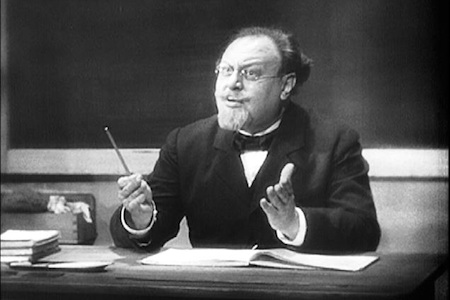[Scene from THE BLUE ANGEL.]
The nightclub in Josef von Sternberg’s The Blue Angel (1930) lacks the sheer ribaldry of the Sandbar in the same director’s The Docks of New York (1928), which plays in a beautiful restoration at the San Francisco Silent Film Festival (July 12-15). The culprit is the cumbersome sound equipment that hampered fluid camera movements of the kind which initiates the Sandbar. And yet more than most films from 1930, The Blue Angel retains the hothouse intensity of the silent gaze while elevating sound as another potentially seductive surface (the songs of women and birds floating through open windows and doors are a constant). The transition figures into the film’s contrasting performances as well, with Emil Jannings’ declamatory acting style going against the grain of Marlene Dietrich’s easy sexuality.
As a paradigmatic silent player, Jannings’ performances are sometimes caricatured by his most outlandish pantomimes. But the framework of character matters. In the case of Dr. Immanuel Rath, a vain professor brought low by his infatuation with the showgirl Lola, Jannings’ tendency to overplay is what makes the character legible as a tragic hero: every ostentatious gesture reveals the narcissistic obsession with authority that leaves his character exposed to humiliation and sadism. Jannings extravagant gestures verge on self-parody—there is the great show he makes of blowing his nose, for instance—but their repetition and variation inscribe the character’s fall. The fact that he’s shamed makes him pathetic; the fact that he’s unable to tolerate this shame makes him dangerous.
After a patient depiction of the characters’ flawed discipline in the first part of the film, degradation comes quickly: the changeover is disclosed with incredible efficiency in the ellipsis shown above. We watch Rath waiting for Lola to finish packing. Rath has just made a grotesque spectacle of his preening nature by crowing like a rooster during their wedding party, but he still paces the room with evident pride. Lola peeks from behind the curtain to ask Rath to fetch her suitcase. Her glossy photographs spill onto the floor, and Rath indigently admonishes her, “As long as I’ve a penny to my name, they will not be sold!” She smiles at his naivete and shifts her weight so as to better frame her figure for the camera (we the audience of The Blue Angel are never so far from the diegetic spectators of the Blue Angel club). Following the fade-out, Rath appears a changed man. He sits hunched smoking at a small nightclub. Where just a moment before he was kneeling before the actual woman, now he’s dwarfed by one of Lola’s promotional posters. She sings off camera (“Beware of blonde women”), and after the lights come up Rath shuffles around the club hawking the same postcards he railed against.
In the case of Dr. Immanuel Rath, a vain professor brought low by his infatuation with the showgirl Lola, Emil Jannings’ tendency to overplay is what makes the character legible as a tragic hero: every ostentatious gesture reveals the narcissistic obsession with authority that leaves his character exposed to humiliation and sadism.
The revelation of Rath’s hypocrisy is scripted, to be sure, but Jannings’ exquisitely controlled performance fleshes out narrative logic with emotional detail. Take the change in how he holds his cigarette. Where in the earlier scene the cigarette flirted with the air as an appendage of self-satisfaction, now it hangs resignedly off his lips. He pulls the cigarette from his mouth and contemplates it for a moment with a look that tells us that he’s lost his taste for this pleasure, which stands in for all the others. His glance towards the stage before stubbing out his cigarette indicates the time that’s passed in between scenes, time enough for this degradation to become routine. Where formerly he buttoned his jacket with great relish, he now does so hurriedly. The nightclub space is thoroughly demystified as he shuffles around the bon vivants, invisible amongst their anonymous faces. Backstage, the manager’s indolent manner with his long cigarette further draws our attention to the way gesture maps the characters’ relative social positions.
Rath’s professor had already been humiliated before this scene, but now he’s no longer blind to this fact. Jannings’ every move expresses the festering self-pity that makes The Blue Angel a sure fit for Siegfried Kracauer’s study, From Caligari to Hitler. More generally, the scene reminds you that an insinuating ellipsis can be a great gift to an actor. For Jannings, it offers the opportunity to contextualize his own performance.




